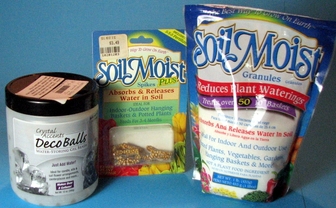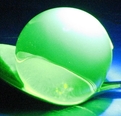
Hydrogels are superabsorbent polymers that have the ability to absorb water in enormous quantities. The polymers can be naturally occurring materials like starch, cellulose and methylcellulose, (wall paper paste), and gelatin, or synthetic materials based on the chemical acrylamide. The resulting polymer is crosslinked to varying degrees and produces materials like polyacrylamide and polyacrylate. The functionality of water absorption can then be used in soil amending or as a material in a babies diaper to absorb urine. So, first, here is a video demonstrating the amazing capacity for distilled water to fill the polymer network:

All of the polymers in this post and in the video are from SoilMoist. They seem to be the major player in this technology and hold several patents on these materials. The parent company is JRM. The soil amendment examples are available at most garden centers and the Deco Balls are available online. I purchased mine at Ace Hardware online. But, I understand that they may be available at craft stores like Michael's and others as well. They are also used in flower decoration so a flower shop may also be a source. In all of these materials simply add an excess of water and when they have expanded to full size, discard the remaining water. However please don't put any of these polymers into the drain. They may swell and cause some real problems! Let them dehydrate and dispose in the trash.
Water absorbing polymers are called hydrogels when they are partially crosslinked and can absorb water through hydrogen bonding. The ability to absorb water is related to the ionic concentration of the water used. The greatest amount that can be absorbed is in distilled water where it can reach 500 times its own weight, or 30 to 60 times its own volume. As an example, if salt water is used the polymer will not swell as the ionic balance has been shifted. So, the anionic or cationic, (minus or plus charge), determines how the polymer will react.
There is also a relationship between how crosslinked the polymer might be and its swelling capacity. Low density crosslinked polymers swell to a larger degree but have a softer and more fragile gel structure. The spheres in the video are quite fragile and will break apart easily when fully loaded with water. Higher crosslinked polymers show less absorption but can maintain their shape and firmness under pressure.
As with many technologies, there can be controversy and hydrogels are no exception. The use of hydrogels for soil amendment and water conservation have been questioned. This PDF link describes the questions and covers other uses for hydrogels. Here. Another link for some additional chemistry explanations and experiments can be found Here. There is of course Wikipedia, and at this time, there is a lot going on in the field of hydrogels. Have some fun and have a swell time...
 RSS Feed
RSS Feed
